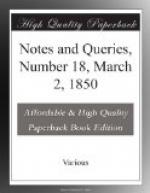That the Pater noster used sometimes to be said with the wicked design of working ill to individuals, and by those who were deemed witches, is clear form the above extract: may not, then, this “wytche’s” Pater noster be the “white” Pater noster, against which the night-spell in Chaucer was employed? “Wyche” may easily be imagined to have glided into “white.”
“Seynte Petres soster,” I suspect has a reference to St. Petronilla’s legend. St. Petronilla, among our forefathers, was called St. Pernell, and The Golden Lengend imprinted 1527, by Wynkyn de Word, tells us, fol. cxxxi. b., that she “was doughter of saynt peter thappostle, whiche was ryght fayre and bewteous, and by the wyll of her fader she was vexed with fevers and akes.” For a long while she lay bed-ridden. From the name of this saint, who went through so many years of her life in sickness, perhaps was borrowed the word “pernell,” to mean a person in a sickly weak state of health, in which sense, Sir Thomas More (Works, London, 1557, p. 893) employs it, while bantering Tindal. St. Peter’s daughter (St. Pernell) came to be looked upon, in this country, as the symbol of bad health under all its forms. Now, if we suppose that the poet mistook, and wrote “soster” instead of “doughter,” we immediately understand the drift of the latter part of the spell, which was, not only to drive away witchcraft, but guard all the folks in that house from sickness of every kind.
Daniel Rock.
Buckland, Faringdon.
* * * * *
REPLIES TO MINOR QUERIES.
By Hook or by Crook—Pokership—Gib Cat—Emerod.—I regret that very pressing business has hitherto prevented me from supplying an omission in my communication relating to the probable derivation of “By Hook or by Crook;” namely, my authority for saying there was evidence of the usage I referred to in forest customs. I now beg to supply that omission, by referring to the numerous claims for fuel wood made by divers persons at the justice seats held in the reigns of Charles I. and Charles II. for the New Forest, and which will be found at the Tower and Chapter House. Among others of these claims, I would mention that made by the tenant of land in Barnford, No. 112., who claims to have had the privilege, from time immemorial, of going into the king’s wood to take the dead branches off the trees therein, “with a cart, a horse, a Hook and a Crook, and a sail cloth.” Verily this necessity for a sail cloth seems to point very distinctly to his being obliged to collect his fire-wood “by Hook or by Crook.” May I add, that I do not think that any of the notes I have seen hitherto, with reference to this subject, invalidate the supposition of the origin being forestal; all that they {282} appear to me to prove is, that the saying is of long standing.




